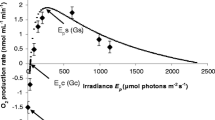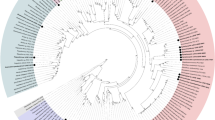Abstract
The unicellular cyanobacterial strain 16Som2, isolated from a Somaliland saltpan and identified asCyanothece sp., is characterized by cells surrounded by a thick polysaccharidic capsule, the external part of which dissolves into the medium during growth, causing a progressive increase in culture viscosity. In spite of this, the thickness of the capsule remained almost constant under all the culture conditions tested, demonstrating that the processes of its synthesis and solubilization occurred at a similar rate. The synthesis of carbohydrates was neither enhanced by increasing salinity (sea-water enriched with NaCl in the range 0 to 2.0 M) nor by Mg2+, K+ or Ca2+ deficiencies. In contrast, N-limitation and, to a lesser extent, P-limitation induced a significant enhancement of carbohydrate synthesis; in particular, N-deficiency stimulated the synthesis of all the carbohydrate fractions (intracellular, capsular and soluble). The soluble polysaccharide, separated from the culture medium and hydrolyzed with 2N trifluoroacetic acid, showed a sugar composition consisting of glucuronic acid: galacturonic acid: galactose: glucose: mannose: xylose: fucose in a molar ratio of 1: 2: 2.4: 6.8: 4.8: 2.9: 1.6.Cyanothece sp. culture subjected to nitrogen starvation synthesized polysaccharide with a mean productivity of 115 mg (EPS) l−1d−1, for the polymer solubilized into the medium, and of 15 mg (CPS) l−1d−1 for the capsular polysaccharide.
Similar content being viewed by others
Abbreviations
- CPS:
-
capsular polysaccharide
- EPS:
-
exocellular polysaccharide
- PAR:
-
photosynthetic active radiation
References
Aller JC (1982) Biosaline research in the United States and Canada. In San Pietro A (ed.), Biosaline Research, a Look to the Future. Plenum Press, New York, 9–18.
Arad S(M) (1988) Production of sulfated polysaccharides from red unicellular algae. In Stadler T, Mollion J, Verdus MC, Karamanos Y, Morvan H, Christiaen D (eds), Algal Biotechnology. Elsevier Applied Science, London, 65–87.
Arad S(M), Friedman O(D), Rotem A (1988) Effect of nitrogen on polysaccharide production in aPorphyridium sp. Appl. environ. Microbiol. 54: 2411–2414.
Balkwill DL, Stevens SE Jr (1980) Glycocalyx ofAgmenellum quadruplicatum. Arch. Microbiol. 128: 8–11.
Borowitzka LJ (1981) The Microflora. Adaptation to life in extremely saline lakes. In Williams WD (ed.), Salt Lakes. Developments in Hydrobiology 5. Dr W. Junk Publishers, The Hague, 33–46. Reprinted from Hydrobiologia 81/82: 33–46.
Brock TD (1976) Halophilic Blue-Green Algae. Arch. Microbiol. 107: 109–111.
Campbell S, Golubic ST (1985) Benthic cyanophytes (cyanobacteria) of Solar Lake (Sinai). Arch. Hydrobiol. 38/39: 311–329.
Cesaro A, Liut G, Bertocchi C, Navarini L, Urbani R (1990) Physicochemical properties of the exocellular polysaccharide fromCyanospira capsulata. Int. J. biol. Macromol. 12: 79–84.
De Philippis R, Sili C, Tassinato G, Vincenzini M, Materassi R (1991) Effects of growth conditions on exopolysaccharide production byCyanospira capsulata. Biores. Technol. 38: 101–104.
Dubinsky O, Barak Z, Geresh S, Arad S(M) (1990) Composition of the cell-wall polysaccharide of the unicellular red algaRhodella reticulata at two phases of growth. In Abstracts of the Fifth International Conference of the Society of Applied Algology, Recent advances in algal biotechnology, P 17.
Dubois M, Gilles KA, Hamilton JK, Rebers PA, Smith F (1956) Colorimetric method for determination of sugars and related substances. Analyt. Chem. 28: 350–356.
Galambos JT (1967) The reaction of carbazole with carbohydrates. I. Effect of borate and sulfamate on the carbazole color of sugars. Analyt. Biochem. 19: 119–132.
Kroen WK, Rayburn WR (1984) Influence of growth status and nutrients on extracellular polysaccharide synthesis by the soil algaChlamydomonas mexicana (Chlorophyceae). J. Phycol. 20: 253–257.
Lange W (1976) Speculations on a possible essential function of the gelatinous sheath of the blue-green algae. Can. J. Microbiol. 22: 1181–1185.
Lapasin R, Pricl S, Bertocchi C, Navarini L, Cesaro A, De Philippis R (1992) Rheology of culture broths and exopolysaccharide ofCyanospira capsulata at different stages of growth. Carbohydr. Polym. 17: 1–10.
Lewis JG, Stanley NF, Guist GC (1988) Commercial production and applications of algal hydrocolloids. In Lembi CA, Waaland JR (eds) Algae and human affairs. Cambridge University Press, Cambridge, 205–237.
Linton JD, Ash SG, Huybrechts L (1991) Microbial polysaccharides. In Byrom D (ed.), Biomaterials. Stockton Press, New York, 215–261.
Lloyd AG, Dodgson KS (1959) Infrared spectra of carbohydrate sulphate esters. Nature 184: 548–549.
Lowry OH, Rosebrough NJ, Farr AL, Randall RJ (1951) Protein measurement with the Folin phenol reagent. J. biol. Chem. 193: 265–275.
Margheri MC, Tredici MR, Barsanti L, Balloni W (1987) The photosynthetic community of the Trapani saline Lagoons: an alternative option for the exploitation of an extreme environment. Ann. Microbiol. 37: 203–215.
Navarini L, Bertocchi C, Cesaro A, Lapasin R, Crescenzi V (1990) Rheology of aqueous solutions of an extracellular polysaccharide fromCyanospira capsulata. Carbohydr. Polym. 12: 169–187.
Painter TJ (1983) Algal polysaccharides. In Aspinall GO (ed.), The polysaccharides, vol 2. Academic Press, New York, 195–285.
Panoff JM, Priem B, Morvan H, Joset F (1988) Sulphated exopolysaccharides produced by two unicellular strains of cyanobacteria,Synechocystis PCC 6803 and 6714. Arch. Microbiol. 150: 558–563.
Percival E (1979) The polysaccharides of green, red and brown seaweeds: their basic structure, biosynthesis and function. Br. phycol. J. 14: 103–117.
Phlips EJ, Zeman C, Hansen P (1989) Growth, photosynthesis, nitrogen fixation and carbohydrate production by a unicellular cyanobacteriumSynechococcus sp (Cyanophyta). J. appl. Phycol. 1: 137–145.
Rippka R, Waterbury JB (1977) The synthesis of nitrogenase by non-heterocystous cyanobacteria. FEMS Microbiol. Lett. 2: 83–86.
Rippka R, Deruelles J, Waterbury JB, Herdman M, Stanier RY (1979) Generic assignments, strain histories and properties of pure culture of cyanobacteria. J. gen. Microbiol. 111: 1–61.
Roussomoustakaki M, Anagnostidis K (1991)Cyanothece halobia, a new planktic chroococcalean cyanophyta from hellenic heliothermal saltworks. Arch. Hydrobiol. 64: 71–95.
Solorzano L (1969) Determination of ammonia in natural waters by the phenolhypoclorite method. Limnol. Oceanogr. 14: 799–801.
Thepenier C, Chaumont D, Gudin C (1988) Mass culture ofPorphyridium cruentum: a multiproduct strategy for the biomass valorization. In Stadler T, Mollion J, Verdus MC, Karamanos Y, Morvan H, Christiaen D (eds), Algal Biotechnology. Elsevier Applied Science, London, 413–420.
Turner GL, Gibson AH (1980) Measurement of nitrogen fixation by indirect means. In Bergerson FI (ed.), Methods for evaluating biological nitrogen fixation. Wiley & Sons, New York, 111–138.
Vincenzini M, De Philippis R, Sili C, Materassi R (1990a) A novel exopolysaccharide from a filamentous cyanobacterium: production, chemical characterization and rheological properties. In Dawes EA (ed.), Novel biodegradable microbial polymers. Kluwer Academic Publishers, Dordrecht, 295–310.
Vincenzini M, De Philippis R, Sili C, Materassi R (1990b) Studies on exopolysaccharide release by diazotrophic batch cultures ofCyanospira capsulata. Appl. Microbiol. Biotechnol. 34: 392–396.
Author information
Authors and Affiliations
Rights and permissions
About this article
Cite this article
De Philippis, R., Margheri, M.C., Pelosi, E. et al. Exopolysaccharide production by a unicellular cyanobacterium isolated from a hypersaline habitat. J Appl Phycol 5, 387–394 (1993). https://doi.org/10.1007/BF02182731
Received:
Revised:
Accepted:
Issue Date:
DOI: https://doi.org/10.1007/BF02182731




